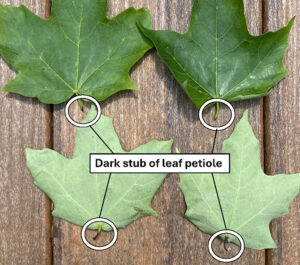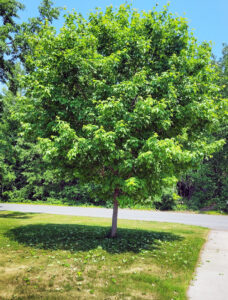
Prematurely fallen sugar maple leaves with normal appearance except for characteristic darkened petiole stubs caused from feeding damage of the maple petiole borer. / Photo Credit: Paul Cigan, Wisconsin DNR
By Paul Cigan, DNR Forest Health Specialist
Paul.Cigan@wisconsin.gov or 715-416-4920
Fallen maple leaves have been observed under Wisconsin maple trees since late May.
The fallen leaves are typically of normal shape, size and color, but have a darkened petiole stub (i.e., leaf stem) remaining. A closer examination of the petiole may reveal a hollow feeding tunnel containing tiny larvae of the insect responsible for the damage inside: the maple petiole borer.
Maple petiole borer is an exotic sawfly insect whose larvae bore into maple leaf petioles, primarily sugar maple, damaging the petiole tissues and causing the leaves to drop prematurely.

Maple leaves littering the ground due to feeding damage by the maple petiole borer, leading to premature leaf drop. / Photo Credit: Paul Cigan, Wisconsin DNR
Hallmark features distinguishing damage caused by maple petiole borer from other common causes of spring leaf drop, such as anthracnose, are the presence of darkened petiole stubs and leaves that otherwise look normal and lacking any curling and/or discoloration.
Although leaf drop caused by maple petiole borer can look dramatic when viewing the ground under a maple tree, the insect rarely causes leaf loss in excess of 30 percent on individual maples and therefore has little impact on tree health.
Chemical control is not recommended, but removing and destroying fallen petioles within 7-10 days after they fall may reduce maple petiole borer populations the following year.
